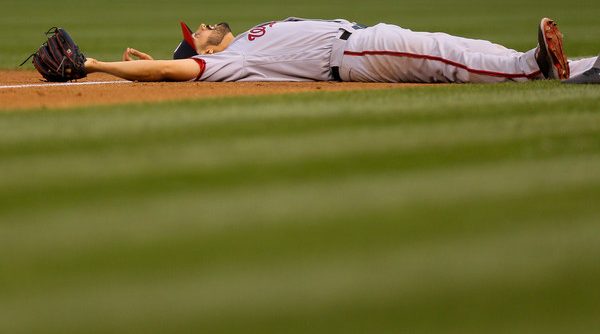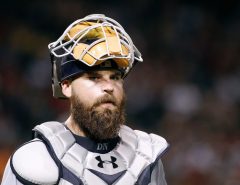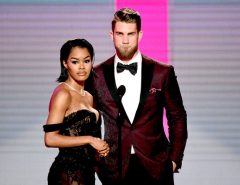As every Nationals fan knows, some days the team gets Good Gio and some days it’s Bad Gio on the mound. In Gonzalez’s 23 starts coming into Tuesday’s game, he’s actually allowed three or fewer runs 15 times. That’s not to say he hasn’t had a couple of clunkers, though, as he’s had three starts of allowing over five runs. Those big blow ups have resulted in a disappointing ERA of 4.24 and frayed the nerves of Nats fans.
Max Scherzer and Stephen Strasburg are two of the top pitchers in all of baseball. Thanks to his ability to induce soft contact, Tanner Roark has solidified his hold on the #3 spot in the rotaion. With Joe Ross still on the DL, the question then becomes, can the Nationals rely on Gio Gonzalez down the stretch?
A lot of Gio’s numbers in 2016 are consistent with his best years in DC. His strikeout rate continues to hover around 22 percent while his walk rate — his Achilles heel from his Oakland days — is the lowest rate of his Nationals’ tenure. Has changeup has been his most valuable pitch. Opposing batters are hitting only .240 in at bats ending with the changeup while swinging and missing nearly 18% of the time against the pitch.
Of course his 4.24 ERA is no fluke. The loss of a couple miles per hour off his fastball velocity has been well documented and now opposing batters are hitting over .275 against the pitch as a result. On the whole, batters have been hitting Gio harder in general than in previous years. The opposition has a hard hit rate of 34% versus Gio, the highest rate he has ever allowed. They are hitting more line drives and fly balls and fewer groundballs, obviously not a promising trend. He’s also getting killed by the home run, with a 1.01 home runs per nine innings pitched rate. That’s his highest rate of long balls allowed since his rookie year with the As. Homers obviously can kill a pitcher’s ERA but, as we noted with Scherzer, it’s a league wide problem and not unique to Gio.
Down the stretch of the regular season, the other concern with Gio is his ability (or lack thereof) to go deep in games. He’s gone at least six innings in 15 of his past 23 starts, but only three times has he pitched past the seventh inning. That means the bullpen is going to have to put in some work anytime Gio pitches.
As one might expect, Gio’s effectiveness in games drops off dramatically the further he pitches into games. The first time through the batting order this season, Gio has allowed only a .618 OPS to opposing teams. The average NL starting pitcher allows a .704 OPS the first time through the order, so Gio has been very effective when facing batters for the first time. All pitchers lose a little effectiveness as they face batters a second and third time in the same game, an effect referred to as the “times through the order penalty.” The average NL start this year goes from that .704 OPS the first time through the order to a .749 OPS the second time and a .777 OPS the third time through. Gio, like all pitchers, falls victim to this penalty but his drop off is much worse than the average pitcher. The second time through the order, opposing hitters have a .761 OPS — a 143 point swing — and a jaw-dropping .802 OPS the third time through the order. Gio quickly goes from an above average pitcher to a below average pitcher within the same game the more looks the opposition gets of him.
Those aren’t encouraging numbers, to be sure, but keep in mind that Gonzalez is only expected to be the fourth best starter on this version of the Nationals. Compare Gio to some of the #4 starters on other playoff hopeful NL teams, and Nationals fans may feel a little better about his spot in the rotation. The Mets, whose rotation of death is slowly but surely falling apart as the season wears on, will have to rely on ageless wonder Bartolo Colon to continue cutting mid 80s fastballs by hitters down the stretch. The Giants brought in Matt Moore to reinforce their rotation, but they will have to keep giving important innings to Jeff Samardzjia and his 4.23 ERA or Jake Peavy with his 5.47 ERA. The Marlins and the Dodgers, meanwhile, will be lucky to have a fourth healthy starting pitcher they can hand the ball to after both team’s rotations have been decimated by injuries. Sure, Gio’s numbers don’t leap off the page, but he’s one of the better fourth starters in baseball.
The Nationals, though, have their eyes firmly set on the post season and the dynamics of pitching changes dramatically come playoff time. Those changes could actually boost Gonzalez’s value in the post season. The team won’t have to worry about Gio’s inability to go deep in ball games or loss of effectiveness as the game wears on. With all the off days built into the playoff calendar, Dusty Baker can ask for five good innings out of Gio. He could ratchet up the velocity, knowing he doesn’t have to save anything in the tank for the late innings. The team can let him get through the opposing batting order twice and then turn the ball over to the newly reinforced bullpen for four innings. While it’s difficult, if not impossible, to quantify, there’s something to be said for throwing a left-handed pitcher into the mix with three other hard throwing right handed starters, too, especially in a five- or seven-game series.
So, no, Gio isn’t a dominant pitcher. He has his obvious flaws. But he’s at least on par with his peers, the other #4 starters in the league. In the playoffs, Gio’s flaws can be reduced or possibly eliminated and he can be put in the best possible situation to succeed. It may not always be pretty, but Gio gives the Nationals a chance to win more times than not.
Tags: Gio Gonzalez, Nationals, Nats, Washington Nationals




Leave a Reply